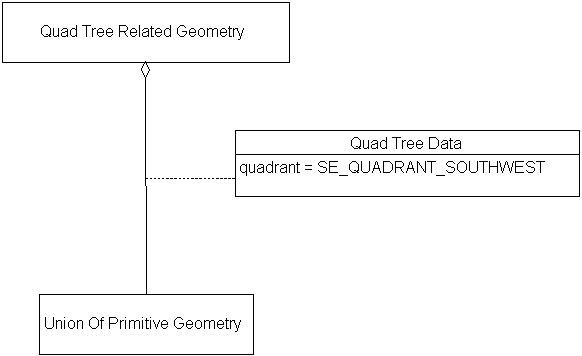The SEDRIS Data Representation Model
APPENDIX A - Classes
Quad Tree Related Geometry
|
|---|
Class Name: Quad Tree Related Geometry
Subclasses
This DRM class is concrete and has no subclasses.
Definition
An instance of this DRM class specifies an aggregation of
<Geometry Hierarchy> objects in
which each component <Geometry Hierarchy>
represents a branch of a Quad Tree. The quadrant represented by a branch is
specified by the <Quad Tree Data>
associated with that branch. The bounding region that the
<Geometry Hierarchy> components occupy is
defined by the <Spatial Domain> of the
<Quad Tree Related Geometry>.
Primary Page in DRM Diagram:
Secondary Pages in DRM Diagram:
This class appears on only one page of the DRM class diagram.
Example
Consider a representation of a region of terrain that is organized into
quadrants, where the
upper-right quadrant consists of ocean, and the other three quadrants
consist of the terrain bordering the ocean. The ocean quadrant is not
represented in the producer's system. The region is represented in SEDRIS
by a <Quad Tree Related Geometry>
with 3 component <Union Of
Primitive Geometry>. (Since the remaining quadrant had no
<Polygon> instances, it was not represented.)

Consider a Quadtree that is represented in a transmittal by
a <Quad Tree Related Geometry>
instance. The southwest quadrant of the Quadtree is a
<Union Of Primitive Geometry>
aggregated by the
<Quad Tree Related Geometry>
as follows:

FAQs
- If a <Quad Tree Related
Geometry> has less than 4 components, why is the data being organized
under a <Quad Tree Related
Geometry> at all?
A <Quad Tree Related Geometry>
is used when an object in the hierarchy contains spatial components that
occupy a certain quadrant. These quadrants might not contain
<Primitive Geometry> objects,
which is why instances of this class can have less than four components.
- Where is the <Spatial Domain> component?
<Quad Tree Related Geometry>
automatically has a <Spatial Domain> component,
component, because it is a <Geometry
Hierarchy>. Unlike <Geometry Hierarchies>
in general, however, <Quad Tree
Related Geometry> has a constraint stating that the
<Spatial Domain> component is mandatory.
Constraints
Associated by (one-way)(inherited)
Associated with (two-way)(inherited)
Composed of (two-way)(inherited)
Composed of (two-way)
Composed of (two-way metadata)(inherited)
Component of (two-way)(inherited)
Notes
Associated with Notes
An association between a <Geometry Hierarchy> instance and a
<Feature> instance indicates that the <Geometry Hierarchy>
and the <Feature> are alternate representations of the same
environmental object.
An association between two <Geometry Hierarchy> instances
indicates that they are alternate representations of the same
environmental object.
An association from a <Hierarchy Summary Item> instance to a
<Geometry Hierarchy> indicates that the <Hierarchy Summary Item>
summarizes that <Geometry Hierarchy>.
An association from a <Reference Surface> instance to a
<Geometry Hierarchy> indicates that the <Geometry Hierarchy>
organizes the geometric objects that specify the resolution
surface of the <Reference Surface>.
Composed of Notes
In the case where multiple <Collision Volume> components are
specified for a given <Aggregate Geometry>, the union of the
volumes thus specified is used in collision detection.
Fields Notes
If this value is SE_TRUE, each 'descendant' of this aggregation -
that is, each <Geometry> instance that exists in the component tree
rooted at the given <Aggregate Geometry> - shall be unique, in the
sense that it shall appear in only one 'branch' of this aggregation.
If unique_descendants is SE_FALSE, at least one <Geometry> instance
appears in more than one 'branch' of the aggregation.
If this value is SE_TRUE, each 'branch' of this aggregation
strictly complies with the organizing principle for its
particular subclass. If this value is SE_FALSE, at least
one 'branch' does not strictly comply with the given
organizing principle. See the organizing principle constraint
for each specific subclass for details.
Prev: Quad Tree Related Features.
Next: Reference Origin.
Up:Index.
|
Last updated: May 15, 2003
|
Copyright © 2003 SEDRIS™
|
|

